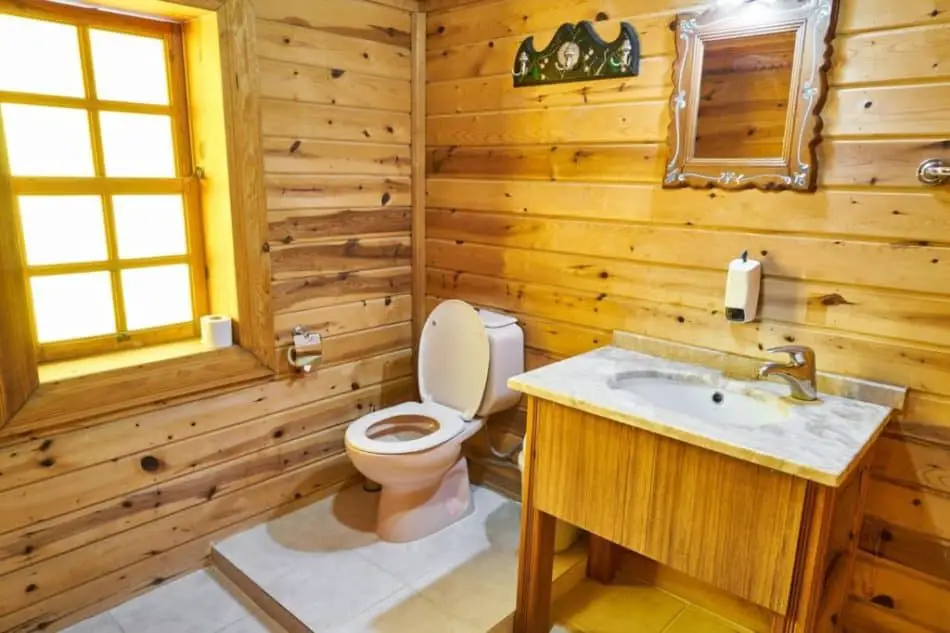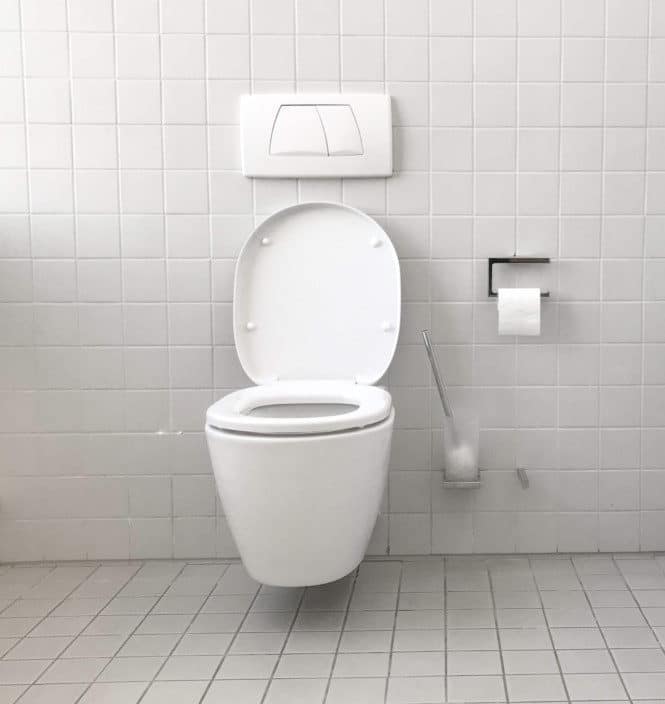
In our world today there are a ton of options for everything, and buying toilet seats is no different. If you need to buy a new toilet seat you’re probably wondering, should I get a wood or plastic toilet seat?
Choosing a wood vs. plastic toilet seat depends primarily on personal preference. Wood toilet seats stay warmer and are more comfortable, but can be hard to clean. Plastic toilet seats are easier to keep clean and are more versatile, but can be uncomfortable, especially in the winter.
To get a more in-depth look at the pros and cons of wood and plastic toilet seats, check out the next section below. We’ll also highlight the pros and cons of using enameled wood toilet seats, which combine some of the benefits of normal wood and plastic toilet seats.
Table of Contents
Wood Veneer Vs. Plastic Toilet Seats

Before we get started we need some clarification, there are two different types of wood toilet seats: enameled wood and wood veneer.
Enameled wood is wood that’s been painted with an enamel protective coating. This gives it a high-gloss finish and makes it appear to be plastic.
Wood veneer is what you probably think of when you think of a wood seat. They are made out of strips of wood, which are formed around a wood core to allow you to see the natural grain.
In this section, we will be comparing wood veneer seats to plastic toilet seats. And in the next section, we’ll do a similar comparison for enameled wood toilet seats.
1. Comfort
If you’ve ever sat on a plastic toilet seat in the middle of winter then you know how shocking it can be. Plastic toilet seats don’t hold in any heat, so when it’s cold, the toilet seat can get REALLY cold.
On the other hand, wooden seats trap some of their own heat. This will keep your toilet feeling significantly warmer compared to its plastic counterparts.
If you live in a home that gets pretty cold in the winter, you might want to consider getting a wood veneer seat for some added comfort.
2. Hygiene
Because wood is a porous material, it can be difficult to clean. The wood can trap some of the things it comes into contact with, like urine, and can hold in the smell if it happens often.
Plastic, however, is a smooth surface, making it very easy to clean and disinfect.
If you have little kids at home that might have some trouble aiming, you probably want to consider getting a plastic or wood enameled seat.
3. Style
A large part of choosing between types of toilet seats is your own personal preference and style.
Wood toilet seats give a warmer more inviting feel. And can fit in well with rustic decor.
Plastic toilet seats give a more sleek, modern appearance.
It’s up to you to decide which one you prefer.
4. Durability
Now, while you may think wood seats will be more durable than plastic, it’s actually the other way around.
Solid wood toilet seats are heavier and have more compressive strength, but they can warp and crack in high heat or humidity. Because of the increased weight, they are often installed using metal hinges which are more durable than the alternatives.
Plastic is not prone to cracking or warping but the smaller plastic pieces, such as the hinges, are more easily broken.
If you live in an area with a high-humidity climate, you probably want to stick with a plastic seat, in order to replace your toilet seat less frequently.
5. Versatility
Plastic seats come in a wider range of styles and shapes than wood seats. If you’ve got an awkward size or shaped toilet, or you want to make sure you can easily get slow-close seats, plastic is the kind of seat for you.
Also, if you want a soft-closing toilet seat (to avoid the loud bang of a toilet seat falling down), then you’ll want to get a plastic toilet seat.
Wood seats are much heavier than plastic seats, which makes it harder and more expensive to have a slow-close toilet seat.
6. Price
When it comes to price, wood veneer toilet seats tend to be on the expensive side of the spectrum.
A lot of what you’re paying for when you buy a wood veneer seat is the look and aesthetic of the seat.
If you’re trying to stay on the cheaper end for replacing your toilet seat then plastic is what you want.
Enameled Wood Vs. Plastic Toilet Seats

Enameled wood is a great option when it comes to toilet seats.
I personally use an enameled wood toilet seat, and I really like it. It gives you the benefits of a plastic seat, but with a couple of additional qualities you might enjoy.
1. Comfort and Style
When it comes to comfort and style, enameled wood toilet seats combine many of the benefits of both plastic and wood veneer toilet seats.
Enameled wood toilet seats tend to retain more heat than plastic toilet seats, making them feel warmer in colder weather.
In addition, enameled wood toilet seats can feel more premium and homey, because they are heavier. Really lightweight plastic toilet seats, on the other hand, can sometimes feel cheap.
Lastly, enameled wood toilet seats are typically white, so they can fit in nicely with more modern decor (compared with wood veneer seats).
2. Weight
Because enameled wood seats have a wood core, they have a lot of added weight. If you’re in the store comparing toilet seats, this can actually be the only noticeable difference between a plastic and an enameled wood toilet seat.
The weight can be both good and bad. It’s good because it can make the seat more durable, and can make it feel more premium. It’s bad because the seat can slam down hard on the bowl, creating quite the racket (or possibly even causing damage).
Sidenote: if you have trouble with your toilet seat falling down all the time, then this post could help you fix it.
3. Hygiene
Because enameled wood is coated with enamel, this gives it a smooth non-porous surface. This makes it just as easy to clean as plastic.
If you have had the same seat for a long time, make sure you check the seat for cracks or wear in the enamel. If the wood core becomes exposed, it can begin to trap germs and even rot if the damage isn’t caught and fixed.
The enamel won’t crack or break very easily though, so you shouldn’t worry about that too much.
4. Durability
Because of the enamel coating, enamel wood toilet seats are not as prone to warping, cracking, or getting scratches compared with wood veneer.
Also, because it’s heavier, wood enamel toilet seats tend to have more durable hardware, compared with the plastic pieces found on plastic seats.
When it comes to durability, you get the best of both worlds with enameled wood toilet seats.
5. Versatility
When it comes to versatility, wood enamel is just as versatile as plastic.
It comes in a wide variety of shapes and sizes.
You can also get the soft close option with an enameled wood seat, but they are a little pricier.
6. Price
Wood enamel seats come in a wide range of prices, some about the same as plastic seats and some much more expensive.
The price range comes from the quality of the seat as well as if you want a soft close toilet seat.
However, a soft close wood enamel seat is about the same price as a regular wood veneer seat.
How to Clean a Wooden Toilet Seat

The main concern people have when deciding between a wood and plastic seat is how to clean a wooden toilet seat. Wooden toilet seats are porous so they have to be cleaned carefully.
If ease of cleaning is a big factor for you, a plastic toilet seat would be best. They are non-porous so you can use most household cleaners on them without any ill effects which makes for easy cleaning.
Wooden seats, on the other hand, can’t be cleaned with harsh, abrasive chemicals because they can make the seat discolored or stained.
You should use mild soap and warm water to wipe down your toilet seat. Make sure you clean between the connective pieces of your toilet seat.
Here are some guidelines when cleaning your wooden seat.
- Use a mild antibacterial soap like dish soap, do not use a toilet bowl cleaner or anything with bleach
- Use a soft sponge or cloth, do not use something abrasive
- Immediately replace your wooden seat if it has cracks or scratches, they build up bacteria
- If you want to disinfect your seat further, wipe it down with a small amount of isopropyl alcohol
Stick to these guidelines and your wooden seat should last you a while.
Related Questions
Are Wooden Toilet Seats Sanitary?
Enameled wood is just as easy to clean and sanitize as plastic. Wood veneer, however, is also sanitary but requires more cleaning than plastic. As wood veneer gets older, it can also trap and hold in the germs and odors of the bathroom.
Do Plastic Toilet Seats Stain?
Plastic toilet seats can get urine stains. However, the urine has to remain on the seat for a while in order to create a stain. If you clean your toilet seat regularly, then staining shouldn’t be a problem. Here’s our guide on how to properly clean a toilet seat: How to Clean a Toilet Seat: Cleaning Your Seat Properly
How Long Do Wooden Toilet Seats Last?
Most toilet seats last for 5-10 years of use. But wooden toilet seats can wear out faster than plastic seats. You should replace your wooden toilet seat if the enamel finish or veneer begins to peel or warp.

